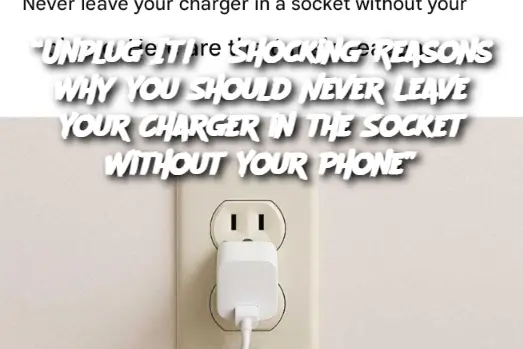-
It wastes energy — even when not in use.
-
Chargers draw what’s called « phantom power » or « vampire energy ». This small but constant drain adds up on your electricity bill, especially if you leave multiple chargers plugged in.
-
-
It poses a fire hazard.
-
Faulty or low-quality chargers can overheat, especially in older outlets or when placed near flammable materials like curtains or beds.
-
-
It shortens the lifespan of the charger.
-
Constant exposure to electricity without a load can lead to internal wear on the charger’s components, causing it to fail earlier.
-
-
It increases the risk of electrical surges.
-
Sudden voltage spikes can damage not only the charger but potentially nearby electronics — especially during storms.
-
-
It may attract dust and moisture.
-
Leaving an unused charger in the socket exposes the prongs and plug to humidity or debris, increasing the risk of corrosion or malfunction.
-
-
It’s a tripping hazard and can damage your outlet.
-
Chargers left dangling from sockets can get pulled accidentally, damaging both the outlet and the charger plug.
-
“Preparation” (What to Do Instead)
-
After charging your phone, always unplug the charger from the wall — not just from your device.
-
Invest in a power strip with a switch, so you can easily cut off power to multiple devices at once.
-
Designate a charging station in your home where chargers are only plugged in when needed.
-
Use smart plugs that can turn off automatically when the device is not in use.
“Serving and Storage Tips” (How to Store Your Chargers Safely)
-
Keep chargers coiled neatly with Velcro or cable ties to avoid tangles and wire damage.
-
Store in a dry, dust-free drawer or tech organizer case.
-
Avoid placing them near heat sources, windows, or areas exposed to direct sunlight.
-
Label your chargers by device or room for quick access and organization.
“Variants” (Different Chargers, Different Risks)
-
Wireless chargers: While convenient, these also draw power constantly and can overheat if left plugged in unnecessarily.
-
Laptop chargers: Often have higher voltage — unplugging is even more important due to fire and surge risks.
-
Portable battery packs: Keep these fully charged but store them unplugged to avoid battery wear.
-
Low-quality chargers: These are especially prone to overheating and should always be unplugged when not in use.
FAQ
Q: Does leaving a charger plugged in really cost that much in electricity?
A: While a single charger may only draw a few cents worth per month, multiple chargers across your home can add up to $100 or more per year in wasted electricity.
Q: What if my charger has an on/off button or indicator light?
A: Even with a light or button, most chargers still draw standby power unless unplugged or connected to a smart plug.
Q: Is it okay to leave my charger plugged in overnight?
A: It’s best to unplug it in the morning, especially if you’re done charging. Overnight charging is safe with quality equipment, but the charger shouldn’t remain plugged in all day.
Q: Can chargers left in the socket catch fire?
A: While rare, cheap or damaged chargers can overheat and start electrical fires, especially in outdated outlets or power strips.
Q: Are newer chargers safer to leave plugged in?
A: Newer models are more energy-efficient, but still not 100% safe or energy-neutral. It’s best to stick to the unplug rule whenever possible.
